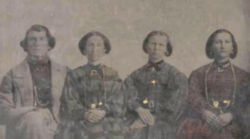Spiritual wifery
| Mormonism and polygamy |
|---|
 Portrait of Ira Eldredge with his three wives: Nancy Black Eldredge, Hannah Mariah Savage Eldredge, and Helvig Marie Andersen Eldredge. |
|
Related articles |
|
|
Spiritual wifery is a term first used in America by the Immortalists in and near the Blackstone Valley of Rhode Island and Massachusetts in the 1740s. The term describes the idea that certain people are divinely destined to meet and share their love (at differing points along the carnal-spiritual spectrum, depending on the particular religious movement involved) after a receiving a spiritual confirmation, and regardless of previous civil marital bonds.[1] Its history in Europe among various Christian primitivistic movements has been well documented.[2] The followers of Jacob Cochran as early as 1818 used "spiritual wifery" to describe their religious doctrine of free love. Often confused with polygamy, spiritual wifery among the Cochranites was the practice in which communal mates were temporarily assigned and reassigned, either by personal preference or religious authority.
The term was later introduced the Latter Day Saint movement by John C. Bennett, who openly applied it to the doctrine of plural marriage. According to Helen Mar Whitney, "At the time [in Nauvoo] spiritual wife was the title by which every woman who entered into this order was called, for it was taught and practiced as a spiritual order."[3] Bennett was soon excommunicated for such offenses.
William Smith, youngest brother of Joseph Smith, and an Apostle of the Church of Jesus Christ of Latter Day Saints,[4][5] in or near Seneca Lake, New York on December 11, 1830, and upon his return to Painesville discovered that his wife had also become a convert.,[6] and briefly Patriarch to The Church of Jesus Christ of Latter-day Saints (LDS Church), wrote a little-known pamphlet in late 1844, called The Elders' Pocket Companion, explaining his own views on the differences between "the Spiritual Wife System" and "plurality of wives". Smith explained that spiritual wifery was the practice of: (1) an Latter Day Saint woman standing as living proxy for her husband's previous civil wife (or wives) to be "sealed" to him for all eternity by the power of Latter Day Saint priesthood, and (2) unmarried Latter Day Saint women being sealed plurally to Latter Day Saint men during the "Millennium" (the post-apocalyptic thousand-year reign of Jesus on the earth). The "plurality of wives doctrine" however, Smith wrote, was simply biblical polygamy as practiced by the "ancient Prophets and Patriarchs". Citing the Book of Mormon, Smith ended his pamphlet emphasizing that the Book of Mormon, while generally proscribing biblical-type polygamy, does include the caveat, "For if I will, saith the Lord of Hosts, raise up a seed unto me, I WILL COMMAND MY PEOPLE" (emphasis is Smith's).[7]
The term complex marriage was later used by the Oneida Community in the 1840s to describe a free marriage practice similar to spiritual wifery.
See also
References
- ↑ William G. McLoughlin, "Free Love, Immortalism, and Perfectionism in Cumberland, Rhode Island, 1748-1768," Rhode Island History 33 (1974), pp. 67-85
- ↑ John L. Brooke, The Refiner's Fire: the Making of Mormon Cosmology, 1644-1844 (Cambridge University Press, 1996), pp. 28, 46, 56, 57, 117, etc.
- ↑ Todd Compton, In Sacred Loneliness: The Plural Wives of Joseph Smith (Signature Books, 1997)
- ↑ Manuscript History of the Church, LDS Church Archives, book A-1, p. 37; reproduced in Dean C. Jessee (comp.) (1989). The Papers of Joseph Smith: Autobiographical and Historical Writings (Salt Lake City, Utah: Deseret Book) 1:302–03.
- ↑ H. Michael Marquardt and Wesley P. Walters (1994). Inventing Mormonism: Tradition and the Historical Record (Salt Lake City, Utah: Signature Books) p. 160.
- ↑ Harper, Steven C. (Summer 2006), "Dictated by Christ", Journal of the Early Republic, University of Pennsylvania Press, 26 (2): 285–286, doi:10.1353/jer.2006.0026, JSTOR 30043410
- ↑ William Smith, The Elders' Pocket Companion, (probably Boston, Massachusetts: self-published, 1844), as quoted in John K. Sheen, Polygamy: or, The Veil Lifted, (York, Nebraska: Self-Published, 1889), pp. 15-21; online at http://olivercowdery.com/smithhome/1880s-1890s/1889She1.htm